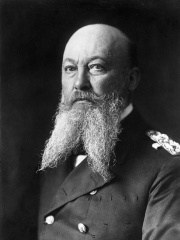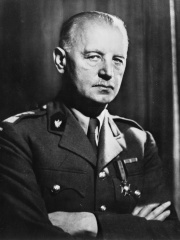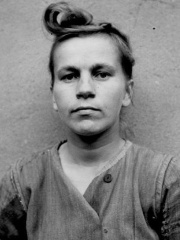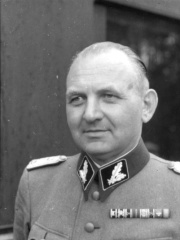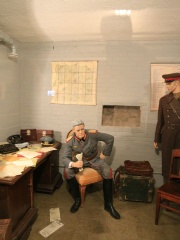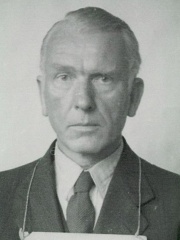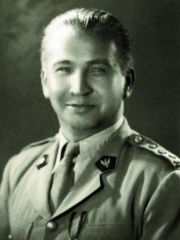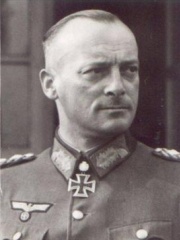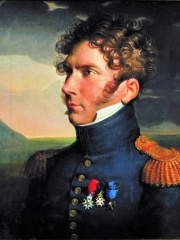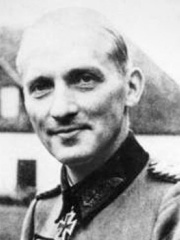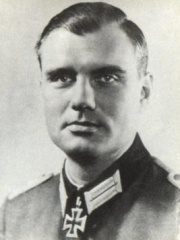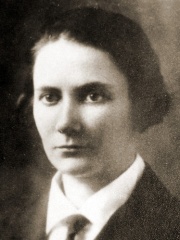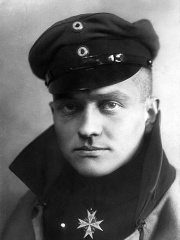
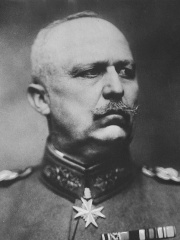
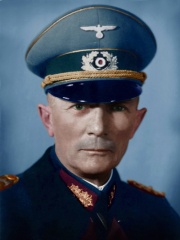
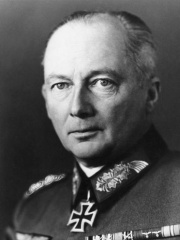
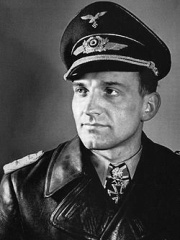
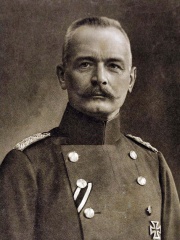
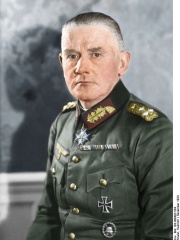
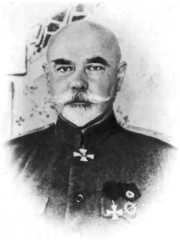
The Most Famous
MILITARY PERSONNELS from Poland
This page contains a list of the greatest Polish Military Personnels. The pantheon dataset contains 2,058 Military Personnels, 69 of which were born in Poland. This makes Poland the birth place of the 7th most number of Military Personnels behind United Kingdom, and Japan.
Top 10
The following people are considered by Pantheon to be the top 10 most legendary Polish Military Personnels of all time. This list of famous Polish Military Personnels is sorted by HPI (Historical Popularity Index), a metric that aggregates information on a biography’s online popularity. Visit the rankings page to view the entire list of Polish Military Personnels.

1. Manfred von Richthofen (1892 - 1918)
With an HPI of 76.45, Manfred von Richthofen is the most famous Polish Military Personnel. His biography has been translated into 57 different languages on wikipedia.
Manfred Albrecht Freiherr von Richthofen (German: [ˈmanfreːt fɔn ˈʁɪçthoːfn̩]; 2 May 1892 – 21 April 1918), known in English as Baron von Richthofen or the Red Baron, was a fighter pilot with the German Air Force during World War I. He is considered the ace-of-aces of the war, being officially credited with 80 air combat victories. Originally a cavalryman, Richthofen transferred to the Air Service in 1915, becoming one of the first members of fighter squadron Jagdstaffel 2 in 1916. He quickly distinguished himself as a fighter pilot, and during 1917 became the leader of Jasta 11. Later he led the larger fighter wing Jagdgeschwader I, better known as "The Flying Circus" or "Richthofen's Circus" because of the bright colours of its aircraft, and perhaps also because of the way the unit was transferred from one area of Entente air activity to another – moving like a travelling circus, and frequently setting up in tents on improvised airfields. By 1918, Richthofen was regarded as a national hero in Germany, and respected by his enemies. Richthofen was shot down and killed near Vaux-sur-Somme on 21 April 1918. There has been considerable discussion and debate regarding aspects of his career, especially the circumstances of his death. He remains one of the most widely known fighter pilots of all time, and has been the subject of many books, films, and other media. Richthofen never married and had no known children.

2. Erich Ludendorff (1865 - 1937)
With an HPI of 73.40, Erich Ludendorff is the 2nd most famous Polish Military Personnel. His biography has been translated into 59 different languages.
Erich Friedrich Wilhelm Ludendorff (German pronunciation: [ˈeːrɪç ˈfʁiːdʁɪç ˈvɪlhɛlm ˈluːdn̩ˌdɔʁf]; 9 April 1865 – 20 December 1937) was a German general, politician and military theorist. He achieved fame during World War I for his central role in the German victories at Liège and Tannenberg in 1914. Following his appointment as First Quartermaster General of the Imperial German Army's Great General Staff in 1916, he became the chief policymaker in a de facto military dictatorship that dominated Germany for the rest of the war. After Germany's defeat, he contributed significantly to the Nazis' rise to power. Erich Ludendorff came from a family of the minor nobility in Kruszewnia, located in the Prussian Province of Posen. After completing his education as a cadet, he received his commission as a junior officer in 1885. In 1893, Ludendorff was admitted to the prestigious German War Academy and was recommended by its commandant to the General Staff Corps only a year later. By 1904, he had rapidly risen in rank to become a member of the Army's Great General Staff, where he oversaw the development of the Schlieffen Plan. Despite being temporarily removed from the Great General Staff for meddling in politics, Ludendorff restored his standing in the army through his success as a commander in World War I. In August 1914, he led the successful German assault on Liège, a feat for which he earned the Pour le Mérite. Upon being transferred to the Eastern Front under the command of General Paul von Hindenburg, Ludendorff was instrumental in inflicting a series of crushing defeats against the Russians, including at Tannenberg and the Masurian Lakes. By August 1916, he had successfully lobbied for Hindenburg's appointment as Supreme Commander as well as his own promotion to First Quartermaster General. Once he and Hindenburg had established what some authors describe as a de facto military dictatorship, Ludendorff directed Germany's entire military strategy and war effort until the end of the conflict. In this capacity, he secured Russia's defeat in the east and launched a new wave of offensives on the Western Front resulting in advances not seen since the war's outbreak. However, by late 1918, all improvements in Germany's fortunes were reversed after its forces' decisive defeat in the Second Battle of the Marne and the Allies' Hundred Days Offensive. Faced with the war effort's collapse and a growing popular revolution, Kaiser Wilhelm II forced Ludendorff to resign. After the war, Ludendorff became a prominent nationalist leader and a promoter of the stab-in-the-back myth, which posited that Germany's defeat and the settlement reached at Versailles were the result of a treasonous conspiracy by Marxists, Freemasons and Jews. He also took part in the failed 1920 Kapp Putsch and 1923 Beer Hall Putsch before unsuccessfully standing for election for President against Hindenburg, his wartime superior. Thereafter, he retired from politics and devoted his final years to the study of military theory. His most famous work in this field was The Total War, where he argued that a nation's entire physical and moral resources should remain forever poised for mobilization because peace was merely an interval in a never-ending chain of wars. Following his death due to liver cancer in Munich in 1937, Ludendorff was given—against his explicit wishes—a state funeral organized and attended by Adolf Hitler.

3. Fedor von Bock (1880 - 1945)
With an HPI of 72.49, Fedor von Bock is the 3rd most famous Polish Military Personnel. His biography has been translated into 53 different languages.
Moritz Albrecht Franz Friedrich Fedor von Bock (3 December 1880 – 4 May 1945) was a German Generalfeldmarschall (Field Marshal) who served in the German Army during the Second World War. Bock served as the commander of Army Group North during the Invasion of Poland in 1939, commander of Army Group B during the Invasion of France in 1940, and later as the commander of Army Group Center during the attack on the Soviet Union in 1941; his final command was that of Army Group South in 1942. Bock commanded Operation Typhoon, the ultimately failed attempt to capture Moscow during the autumn and winter of 1941. The Wehrmacht offensive was slowed by stiff Soviet resistance around Mozhaisk, and also by the rasputitsa, the season of rain and mud in Central Russia. The Soviet counteroffensive soon drove the German army into retreat, and Bock was subsequently relieved of command by Adolf Hitler. A monarchist, Bock was not heavily involved in politics and he did not sympathize with plots to overthrow Adolf Hitler. Bock was also uncommonly outspoken, a privilege Hitler extended to him only because he had been successful in battle.Bock, his second wife and his stepdaughter were killed by a strafing Royal New Zealand Air Force fighter-bomber on 4 May 1945 as they traveled by car towards Hamburg.

4. Günther von Kluge (1882 - 1944)
With an HPI of 71.32, Günther von Kluge is the 4th most famous Polish Military Personnel. His biography has been translated into 45 different languages.
Günther Adolf Ferdinand von Kluge (30 October 1882 – 19 August 1944) was a German Generalfeldmarschall (Field Marshal) during World War II who held commands on both the Eastern and Western Fronts. He commanded the 4th Army of the Wehrmacht during the invasion of Poland in 1939 and the Battle of France in 1940, earning a promotion to Generalfeldmarschall. Kluge went on to command the 4th Army in Operation Barbarossa (the invasion of the Soviet Union) and the Battle for Moscow in 1941. Amid the crisis of the Soviet counter-offensive in December 1941, Kluge was promoted to command Army Group Centre replacing Field Marshal Fedor von Bock. Several members of the German military resistance to Adolf Hitler served on his staff, including Henning von Tresckow. Kluge was aware of the plotters' activities but refused to offer his support unless Hitler was killed. His command on the Eastern Front lasted until October 1943 when Kluge was badly injured in a car accident. Following a lengthy recuperation, Kluge was appointed OB West (Supreme Commander West) in occupied France in July 1944, after his predecessor, Field Marshal Gerd von Rundstedt, was dismissed for defeatism. Kluge's forces were unable to stop the momentum of the Allied invasion of Normandy, and he began to realise that the war in the West was lost. Although Kluge was not an active conspirator in the 20 July plot, in the aftermath of the failed coup he committed suicide on 19 August 1944, after having been recalled to Berlin for a meeting with Hitler. Kluge was replaced by Field Marshal Walter Model.
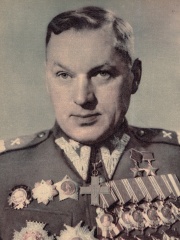
5. Konstantin Rokossovsky (1896 - 1968)
With an HPI of 70.23, Konstantin Rokossovsky is the 5th most famous Polish Military Personnel. His biography has been translated into 58 different languages.
Konstantin Konstantinovich Rokossovsky (Russian: Константин Константинович (Ксаверьевич) Рокоссовский; Polish: Konstanty Rokossowski; 21 December 1896 – 3 August 1968) was a Soviet and Polish officer who became a Marshal of the Soviet Union, a Marshal of Poland, and served as Poland's Defence Minister from 1949 until his removal in 1956 during the Polish October. He became one of the most prominent Red Army commanders of World War II. Born in Warsaw (in present-day Poland; then part of the Russian Empire), or, according to other sources, in Velikiye Luki, Rokossovsky served in the Imperial Russian Army during World War I. In 1917 he joined the Red Guards and in 1918 the newly-formed Red Army; he fought with great distinction during the Russian Civil War of 1917–1922. Rokossovsky held senior commands until 1937 when he fell victim to the Great Purge, during which he was branded a traitor, imprisoned and tortured. After Soviet failures in the Winter War of 1939–1940, Rokossovsky was taken out of prison and reinstated due to an urgent need for experienced officers. Following Germany's invasion of the Soviet Union in June 1941, Rokossovsky played key roles in the defense of Moscow (1941–1942) and the counter-offensives at Stalingrad (1942–1943) and Kursk (1943). He was instrumental in planning and executing part of Operation Bagration (1944)—one of the most decisive Red Army successes of the war—for which he was made a Marshal of the Soviet Union. After the war, Rokossovsky became Defence Minister and deputy chairman of the Council of Ministers in the newly-established Polish People's Republic. Forced out of office in Poland in 1956 after Władysław Gomułka became the leader of Poland, Rokossovsky then returned to the Soviet Union, where he lived out the rest of his life until his death in 1968.

6. Hans-Ulrich Rudel (1916 - 1982)
With an HPI of 69.64, Hans-Ulrich Rudel is the 6th most famous Polish Military Personnel. His biography has been translated into 44 different languages.
Hans-Ulrich Rudel (2 July 1916 – 18 December 1982) was a German ground-attack pilot during World War II and a post-war neo-Nazi activist. The most decorated German pilot of the war and the only recipient of the Knight's Cross with Golden Oak Leaves, Swords, and Diamonds, Rudel was credited with the destruction of 519 tanks, one battleship, one cruiser, 70 landing craft and 150 artillery emplacements. He claimed nine aerial victories and the destruction of more than 800 vehicles. He flew 2,530 ground-attack missions exclusively on the Eastern Front, usually flying the Junkers Ju 87 "Stuka" dive bomber. Rudel surrendered to US forces in 1945 and emigrated to Argentina. An unrepentant Nazi, he helped fugitives escape to Latin America and the Middle East, and sheltered Josef Mengele, the former SS doctor at Auschwitz. He worked as an arms dealer to several right-wing regimes in South America, for which he was placed under observation by the US Central Intelligence Agency. In the West German federal election of 1953, Rudel was the top candidate for the far-right German Reich Party but was not elected. Following the fall of Perón, Rudel moved to Paraguay, where he acted as a foreign representative for several German companies. In 1976, Rudel attended a conference in the United States with various members of the United States military and defense industry as part of the development of the A-10 Thunderbolt II; Rudel's status as a highly decorated attack aircraft pilot and particularly his experience at destroying Soviet tanks from the air was considered relevant to a potential conflict between NATO and the Warsaw Pact.

7. Erich von Falkenhayn (1861 - 1922)
With an HPI of 69.32, Erich von Falkenhayn is the 7th most famous Polish Military Personnel. His biography has been translated into 46 different languages.
General Erich Georg Sebastian Anton von Falkenhayn (11 September 1861 – 8 April 1922) was a German general who was the second Chief of the German General Staff of the First World War from September 1914 until 29 August 1916. Falkenhayn replaced General Helmuth von Moltke the Younger after his invasion of France was stopped at the First Battle of the Marne and was in turn removed on 29 August 1916 after the failure of his offensive strategy in the west at the Battle of Verdun, the opening of the Battle of the Somme, the Brusilov Offensive and the Romanian entry into the war. Having planned to win the war before 1917, the German army was reduced to hanging on. Falkenhayn was given important field commands in Romania and Syria. His reputation as a war leader was attacked in Germany during and after the war, especially by the faction supporting Field Marshal Paul von Hindenburg. Falkenhayn held that Germany could not win the war by a decisive battle but would have to reach a compromise peace; his enemies said he lacked the resolve necessary to win a decisive victory. Falkenhayn's relations with the Chancellor Theobald von Bethmann Hollweg were troubled and undercut Falkenhayn's plans.

8. Werner von Blomberg (1878 - 1946)
With an HPI of 68.90, Werner von Blomberg is the 8th most famous Polish Military Personnel. His biography has been translated into 40 different languages.
Werner Eduard Fritz von Blomberg (2 September 1878 – 13 March 1946) was a German General Staff officer and the first Minister of War in Adolf Hitler's government. After serving on the Western Front in World War I, Blomberg was appointed chief of the Truppenamt ("Troop Office") during the Weimar Republic. Following the Nazis' rise to power, he was named Minister of War and Commander-in-Chief of the German Armed Forces. In this capacity, Blomberg played a central role in Germany's military build-up during the years leading to World War II. However, by 20 January 1938, he was forced to resign after his rivals, Hermann Göring and Heinrich Himmler, presented Hitler with evidence that his wife had posed in the past for pornographic photos.

9. Anton Denikin (1872 - 1947)
With an HPI of 67.58, Anton Denikin is the 9th most famous Polish Military Personnel. His biography has been translated into 51 different languages.
Anton Ivanovich Denikin (Russian: Антон Иванович Деникин, IPA: [ɐnˈton ɪˈvanəvʲɪtɕ dʲɪˈnʲikʲɪn]; 16 December [O.S. 4 December] 1872 – 7 August 1947) was a Russian military leader who served as the acting supreme ruler of the Russian State and the commander-in-chief of the armed forces of South Russia during the Russian Civil War of 1917–1923. Previously, he was a general in the Imperial Russian Army during World War I. His forces' implementation of the White Terror was known for pogroms.
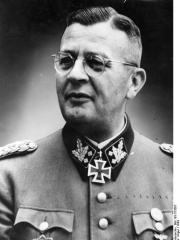
10. Erich von dem Bach-Zelewski (1899 - 1972)
With an HPI of 66.03, Erich von dem Bach-Zelewski is the 10th most famous Polish Military Personnel. His biography has been translated into 32 different languages.
Erich Julius Eberhard von dem Bach-Zelewski (born Erich Julius Eberhard von Zelewski; 1 March 1899 – 8 March 1972) was a high-ranking SS commander of Nazi Germany of Kashubian-Polish origin. During World War II, he was in charge of the Nazi security warfare against those designated by the regime as ideological enemies and any other persons deemed to present danger to the Nazi rule or Wehrmacht's rear security in the occupied territories of Eastern Europe. It mostly involved atrocities against the civilian population. In 1944, he led the brutal suppression of the Warsaw Uprising. Despite his responsibility for numerous war crimes and crimes against humanity, Bach-Zelewski did not stand trial in the Nuremberg trials, and instead appeared as a witness for the prosecution. He was later convicted for politically motivated murders committed before the war and died in prison in 1972.
People
Pantheon has 81 people classified as Polish military personnels born between 1667 and 1951. Of these 81, none of them are still alive today. The most famous deceased Polish military personnels include Manfred von Richthofen, Erich Ludendorff, and Fedor von Bock. As of April 2024, 11 new Polish military personnels have been added to Pantheon including Elisabeth Volkenrath, Fritz Freitag, and Otto Lasch.
Deceased Polish Military Personnels
Go to all RankingsManfred von Richthofen
1892 - 1918
HPI: 76.45
Erich Ludendorff
1865 - 1937
HPI: 73.40
Fedor von Bock
1880 - 1945
HPI: 72.49
Günther von Kluge
1882 - 1944
HPI: 71.32
Konstantin Rokossovsky
1896 - 1968
HPI: 70.23
Hans-Ulrich Rudel
1916 - 1982
HPI: 69.64
Erich von Falkenhayn
1861 - 1922
HPI: 69.32
Werner von Blomberg
1878 - 1946
HPI: 68.90
Anton Denikin
1872 - 1947
HPI: 67.58
Erich von dem Bach-Zelewski
1899 - 1972
HPI: 66.03
Alfred von Tirpitz
1849 - 1930
HPI: 65.70
Władysław Sikorski
1881 - 1943
HPI: 65.54
Newly Added Polish Military Personnels (2024)
Go to all RankingsElisabeth Volkenrath
1919 - 1945
HPI: 60.98
Fritz Freitag
1894 - 1945
HPI: 57.22
Otto Lasch
1893 - 1971
HPI: 53.77
Günther Pancke
1899 - 1973
HPI: 52.77
Leopold Okulicki
1898 - 1946
HPI: 52.51
Friedrich Schulz
1897 - 1976
HPI: 50.98
Michał Gedeon Radziwiłł
1778 - 1850
HPI: 50.36
Wilhelm Hasse
1894 - 1945
HPI: 50.09
Theodor Tolsdorff
1909 - 1978
HPI: 49.64
Johannes Block
1894 - 1945
HPI: 48.26
Maria Wittek
1899 - 1997
HPI: 46.29
Overlapping Lives
Which Military Personnels were alive at the same time? This visualization shows the lifespans of the 25 most globally memorable Military Personnels since 1700.

